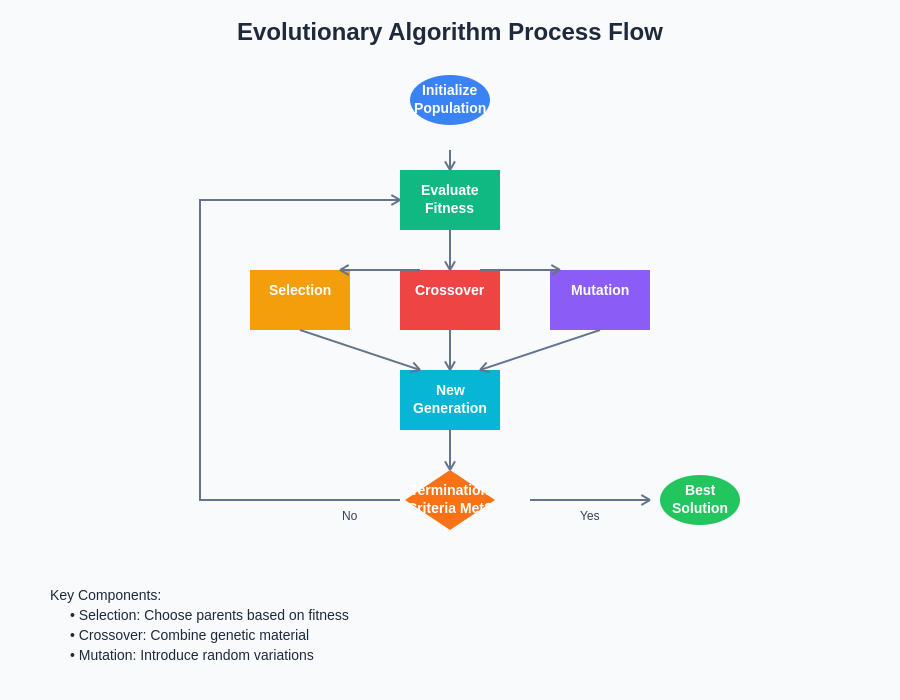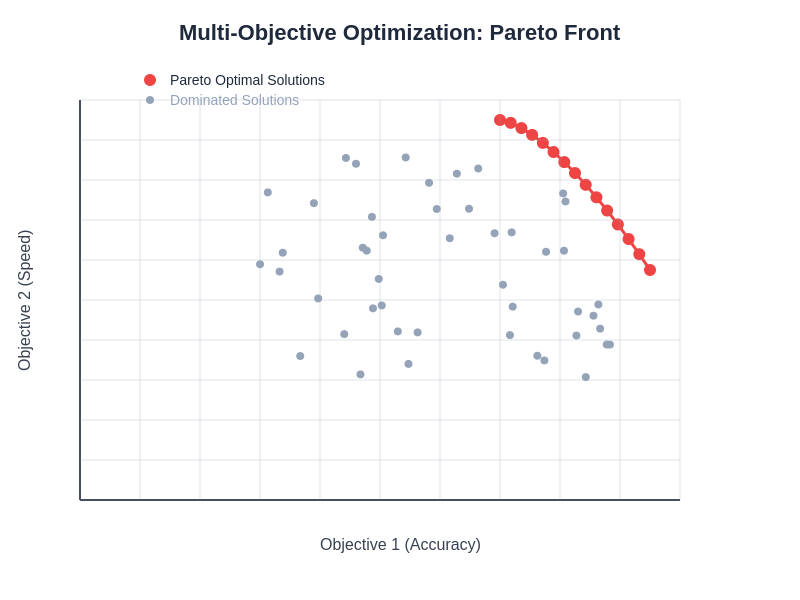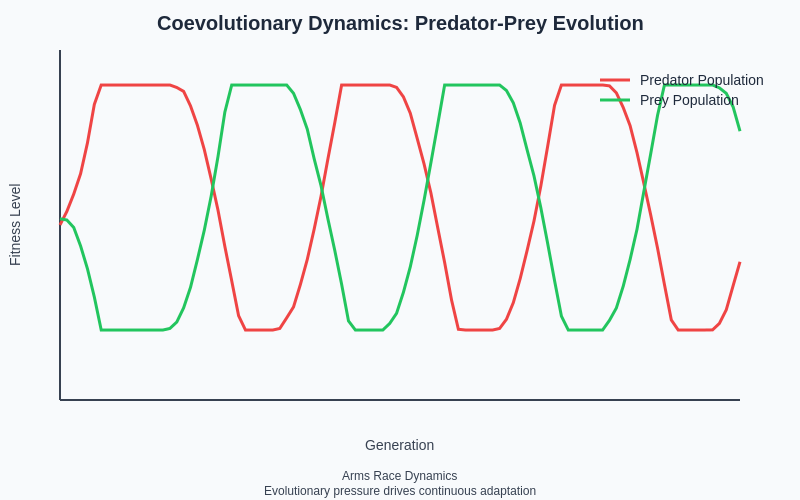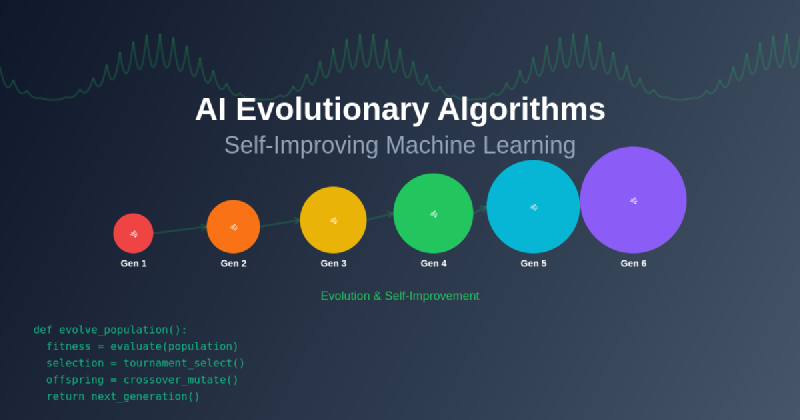The convergence of evolutionary biology principles with artificial intelligence has birthed one of the most fascinating and promising domains in modern machine learning: evolutionary algorithms that enable AI systems to improve themselves autonomously. This revolutionary approach transcends traditional machine learning paradigms by incorporating the fundamental mechanisms of natural selection, mutation, and adaptation into computational systems, creating artificial entities capable of continuous self-enhancement and evolutionary progress.
Explore the latest AI research trends to understand how evolutionary approaches are reshaping the future of intelligent systems. The marriage of evolutionary principles with machine learning represents a paradigmatic shift from static, pre-programmed intelligence toward dynamic, self-adapting systems that mirror the resilience and adaptability observed in natural biological evolution.
The Biological Foundation of Computational Evolution
Evolutionary algorithms draw their inspiration from the profound mechanisms that have driven biological evolution for billions of years, translating concepts such as natural selection, genetic recombination, and environmental adaptation into computational frameworks that can optimize and improve artificial intelligence systems. This biomimetic approach recognizes that evolution represents perhaps the most successful optimization process in natural history, having produced the extraordinary complexity and diversity of life forms through relatively simple principles applied over extended periods.
The fundamental premise underlying evolutionary algorithms rests on the observation that biological evolution operates through iterative cycles of variation, selection, and reproduction, where beneficial traits become more prevalent in subsequent generations while disadvantageous characteristics gradually disappear from the population. This process, when applied to artificial intelligence systems, enables the creation of self-improving algorithms that can adapt to new challenges, optimize their performance, and discover novel solutions without explicit human programming or intervention.
The transition from biological to computational evolution requires careful abstraction of essential evolutionary mechanisms while maintaining the core principles that make natural selection so effective. This involves representing potential solutions as digital genomes, implementing selection pressures that favor superior performance, and enabling genetic operators such as crossover and mutation to generate new candidate solutions through controlled randomization and recombination processes.
Genetic Programming and Code Evolution
Among the most remarkable applications of evolutionary algorithms lies genetic programming, a sophisticated technique that enables computer programs to evolve and improve their own code through iterative evolutionary processes. This approach treats computer programs as evolving organisms, where the program structure serves as the genome, and program performance determines fitness for survival and reproduction in subsequent generations.
Genetic programming operates by representing computer programs as tree structures or linear sequences of instructions that can be modified through evolutionary operators such as crossover, mutation, and selection. The system begins with a population of randomly generated programs and evaluates their performance against specific objectives or fitness criteria. Programs demonstrating superior performance are more likely to contribute their genetic material to the next generation, while poorly performing programs are gradually eliminated from the population.
The evolutionary process in genetic programming involves sophisticated mechanisms for program modification and recombination. Crossover operations exchange subtrees or code segments between parent programs, potentially combining beneficial features from different solutions to create offspring with enhanced capabilities. Mutation operators introduce random modifications to program structure, enabling exploration of novel solution spaces and preventing premature convergence to suboptimal solutions.
Enhance your AI development with advanced tools like Claude that can assist in implementing and understanding complex evolutionary programming concepts. The synergy between human insight and AI assistance accelerates the development of sophisticated evolutionary systems that push the boundaries of self-improving artificial intelligence.
Neural Network Evolution and Neuroevolution
The application of evolutionary principles to neural network optimization has given rise to neuroevolution, a powerful paradigm that enables artificial neural networks to evolve their architecture, weights, and learning algorithms through evolutionary processes. This approach addresses fundamental limitations of traditional neural network training methods by enabling exploration of novel network topologies and optimization strategies that might be difficult or impossible to discover through conventional gradient-based optimization techniques.
Neuroevolution encompasses multiple levels of neural network evolution, ranging from simple weight optimization in fixed-topology networks to sophisticated approaches that simultaneously evolve network architecture, connection patterns, learning rules, and activation functions. This comprehensive evolutionary approach enables the discovery of neural network designs that are specifically adapted to particular problem domains and may exhibit superior performance compared to manually designed architectures.

The evolutionary process in neuroevolution typically involves encoding neural network parameters and topology information into genetic representations that can be manipulated through standard evolutionary operators. Population-based approaches maintain diverse collections of neural network candidates, enabling parallel exploration of different architectural possibilities and preventing premature convergence to locally optimal solutions that might limit overall system performance.
Advanced neuroevolution techniques incorporate sophisticated mechanisms for managing network complexity and preventing excessive growth or bloat in evolved architectures. These approaches often include fitness penalties for overly complex networks, parsimony pressure that favors simpler solutions with equivalent performance, and specialized operators designed to maintain architectural diversity and prevent evolutionary stagnation.
Self-Modifying Algorithm Architectures
The development of self-modifying algorithm architectures represents one of the most ambitious applications of evolutionary algorithms, where artificial intelligence systems are granted the capability to modify their own computational processes, learning algorithms, and decision-making mechanisms through evolutionary optimization. This approach transcends traditional machine learning paradigms by enabling AI systems to adapt not only their parameters and outputs but also their fundamental computational strategies and problem-solving approaches.
Self-modifying algorithms operate through sophisticated meta-learning frameworks that treat the algorithm itself as an evolvable entity subject to evolutionary pressures and optimization. These systems maintain populations of algorithmic variants, each representing different approaches to problem-solving, learning, or optimization. Through competitive evaluation and selective reproduction, superior algorithmic strategies proliferate while inferior approaches are gradually eliminated from the population.
The implementation of self-modifying architectures requires careful consideration of computational stability and safety constraints to prevent evolutionary processes from generating algorithms that exhibit unpredictable or potentially harmful behaviors. This involves incorporating robust evaluation frameworks, implementing safeguards against infinite loops or resource consumption, and maintaining mechanisms for reverting to stable algorithmic states when evolutionary modifications produce undesirable outcomes.
Adaptive Fitness Landscapes and Dynamic Optimization
Evolutionary algorithms operating in dynamic environments must navigate adaptive fitness landscapes that change over time, requiring sophisticated mechanisms for tracking environmental shifts and adapting optimization strategies accordingly. This challenge mirrors the dynamic nature of real-world biological evolution, where environmental changes continuously reshape selective pressures and require ongoing adaptation for survival and reproductive success.
The management of dynamic fitness landscapes involves implementing sophisticated tracking mechanisms that monitor environmental changes and adjust evolutionary parameters in response to shifting optimization objectives. These adaptive systems must balance exploitation of currently successful solutions with exploration of potentially beneficial alternatives that might become advantageous as environmental conditions evolve.
Advanced dynamic optimization techniques incorporate predictive modeling capabilities that attempt to anticipate future environmental changes and pre-adapt populations to emerging challenges. These forward-looking approaches enable evolutionary algorithms to maintain high performance even during periods of rapid environmental transition, providing robustness and resilience that static optimization approaches cannot achieve.
Discover comprehensive AI research capabilities with Perplexity to stay informed about cutting-edge developments in adaptive optimization and dynamic evolutionary systems. The integration of multiple AI research tools creates a comprehensive understanding of rapidly evolving evolutionary algorithm technologies and their applications across diverse domains.
Multi-Objective Evolutionary Optimization
Real-world applications of evolutionary algorithms often involve optimizing multiple conflicting objectives simultaneously, requiring sophisticated approaches that can identify and maintain diverse sets of trade-off solutions rather than converging to single optimal points. Multi-objective evolutionary optimization addresses this challenge by implementing Pareto-based selection mechanisms that preserve solution diversity while advancing toward optimal trade-off frontiers.
The complexity of multi-objective optimization arises from the need to balance competing objectives that may exhibit fundamental conflicts, such as maximizing performance while minimizing computational complexity, or achieving high accuracy while maintaining interpretability. Evolutionary algorithms excel in this domain because their population-based nature enables simultaneous exploration of multiple trade-off solutions, providing decision-makers with comprehensive option sets for selecting appropriate compromises.

Advanced multi-objective evolutionary algorithms incorporate sophisticated diversity preservation mechanisms that prevent convergence to narrow regions of the objective space and maintain broad coverage of the Pareto-optimal frontier. These techniques often involve clustering-based selection, crowding distance calculations, and specialized mating restrictions that encourage exploration of underrepresented regions in the objective space.
Evolutionary Ensemble Learning and Hybrid Approaches
The integration of evolutionary algorithms with ensemble learning techniques has produced powerful hybrid approaches that combine the diversity-generating capabilities of evolution with the performance benefits of ensemble methods. These evolutionary ensemble systems maintain populations of diverse learning algorithms or model configurations, using evolutionary selection to identify optimal combinations and weightings for ensemble formation.
Evolutionary ensemble learning addresses fundamental challenges in traditional ensemble construction by automating the selection of base learners, optimizing combination strategies, and adapting ensemble composition to changing data distributions or problem requirements. This automated approach reduces the need for domain expertise in ensemble design while potentially discovering novel combination strategies that human designers might overlook.
The evolutionary optimization of ensemble systems often involves complex multi-level optimization problems where individual ensemble members must be optimized for performance while the overall ensemble structure is simultaneously optimized for diversity and complementarity. This hierarchical optimization challenge requires sophisticated evolutionary approaches that can coordinate optimization across multiple organizational levels effectively.
Swarm Intelligence and Collective Optimization
Evolutionary algorithms have natural connections to swarm intelligence approaches that enable collective optimization through coordinated behavior of multiple autonomous agents. These swarm-based evolutionary systems leverage principles from social insects, flocking behaviors, and other collective phenomena to achieve optimization performance that exceeds the capabilities of individual agents operating independently.
Particle swarm optimization represents one of the most successful examples of swarm-based evolutionary computation, where individual particles navigate solution spaces through velocity updates influenced by personal best positions, global best positions, and social interactions with neighboring particles. This approach combines individual learning with collective knowledge sharing to achieve robust optimization performance across diverse problem domains.
Advanced swarm intelligence techniques incorporate adaptive topology management, dynamic neighborhood structures, and multi-swarm coordination mechanisms that enable sophisticated optimization behaviors in complex or dynamic environments. These approaches often exhibit emergent optimization capabilities that arise from simple individual behaviors but produce sophisticated collective problem-solving abilities.
Coevolutionary Systems and Competitive Dynamics
Coevolutionary approaches extend traditional evolutionary algorithms by enabling multiple populations to evolve simultaneously in competitive or cooperative relationships, creating dynamic fitness landscapes where the evolution of one population influences the selective pressures experienced by others. This approach mirrors natural coevolutionary processes such as predator-prey relationships, symbiotic interactions, and arms races between competing species.
Competitive coevolution has proven particularly effective for developing game-playing algorithms, adversarial learning systems, and robust optimization solutions that must perform well against diverse or adaptive opponents. The continuous pressure from evolving competitors prevents stagnation and encourages ongoing innovation and adaptation in ways that static fitness evaluation cannot achieve.
Cooperative coevolution addresses the challenge of optimizing high-dimensional problems by decomposing complex optimization tasks into smaller subproblems that can be evolved independently while maintaining coordination through periodic integration and evaluation. This divide-and-conquer approach enables evolutionary algorithms to scale to much larger and more complex optimization problems than would be feasible with traditional single-population approaches.

Real-World Applications and Industrial Implementation
The practical applications of evolutionary algorithms span numerous industries and domains, demonstrating the versatility and effectiveness of self-improving machine learning approaches in solving complex real-world problems. Automotive industry applications include evolutionary optimization of engine designs, aerodynamic configurations, and autonomous vehicle control systems that must adapt to diverse driving conditions and environmental factors.
Financial services leverage evolutionary algorithms for portfolio optimization, algorithmic trading strategy development, and risk management systems that must continuously adapt to changing market conditions and regulatory requirements. These applications often involve multi-objective optimization challenges where profitability must be balanced against risk constraints and regulatory compliance requirements.
Pharmaceutical and biotechnology companies employ evolutionary algorithms for drug discovery, protein folding prediction, and molecular design optimization. These applications benefit from the ability of evolutionary approaches to explore vast chemical and biological design spaces while incorporating complex constraints related to toxicity, bioavailability, and manufacturing feasibility.
Challenges and Limitations in Evolutionary AI
Despite their powerful capabilities, evolutionary algorithms face significant challenges and limitations that must be carefully considered in practical applications. Computational complexity represents a primary concern, as evolutionary approaches often require extensive population evaluations and may converge slowly compared to gradient-based optimization methods, particularly in high-dimensional spaces or when fitness evaluation is computationally expensive.
The challenge of premature convergence poses another significant limitation, where evolutionary populations lose diversity too quickly and become trapped in suboptimal regions of the solution space. This problem is particularly acute in deceptive fitness landscapes where local optima may mislead the evolutionary search process and prevent discovery of global optimal solutions.
Parameter sensitivity represents an ongoing challenge in evolutionary algorithm design, as the performance of these systems often depends critically on appropriate selection of population sizes, mutation rates, crossover probabilities, and selection pressures. The optimization of these meta-parameters often requires extensive experimentation and domain expertise, potentially limiting the accessibility of evolutionary approaches to non-expert users.
Future Directions and Emerging Paradigms
The future of evolutionary algorithms in artificial intelligence points toward increasingly sophisticated self-improving systems that can adapt not only their solutions but also their evolutionary processes and optimization strategies. Meta-evolutionary approaches that evolve the evolutionary algorithm itself represent a promising direction for creating truly autonomous self-improving systems that can adapt to novel problem domains without human intervention.
Quantum evolutionary computing represents an emerging paradigm that leverages quantum computational principles to enhance evolutionary optimization capabilities. These approaches may enable exploration of exponentially larger solution spaces and implement quantum parallelism to accelerate evolutionary search processes, potentially overcoming fundamental limitations of classical evolutionary computation.
The integration of evolutionary algorithms with advanced artificial intelligence techniques such as deep learning, reinforcement learning, and natural language processing continues to produce novel hybrid approaches that combine the strengths of different paradigms. These integrative approaches may enable the development of more general artificial intelligence systems that can adapt and improve across diverse task domains.
Ethical Considerations and Safety Measures
The development of self-improving AI systems through evolutionary algorithms raises important ethical considerations and safety concerns that must be addressed through careful design and implementation practices. The autonomous nature of evolutionary improvement processes creates potential risks related to unpredictable system behavior, unintended optimization objectives, and the possibility of systems evolving in ways that conflict with human values or safety requirements.
Ensuring alignment between evolutionary optimization objectives and human values requires sophisticated reward function design and multi-stakeholder evaluation processes that can identify and prevent potentially harmful evolutionary directions. This challenge is particularly complex because evolutionary systems may discover novel approaches that achieve specified objectives through unexpected means that were not anticipated during system design.
The implementation of robust monitoring and control mechanisms represents a critical safety requirement for evolutionary AI systems. These mechanisms must be capable of detecting potentially problematic evolutionary trends, implementing emergency stop procedures when necessary, and maintaining human oversight capabilities throughout the evolutionary improvement process.
Conclusion and Industry Transformation
Evolutionary algorithms represent a transformative approach to artificial intelligence that enables truly self-improving systems capable of continuous adaptation and optimization without explicit human programming. The integration of evolutionary principles with machine learning creates opportunities for developing AI systems that can evolve and adapt to novel challenges while maintaining robust performance across diverse application domains.
The ongoing advancement of evolutionary AI technologies promises to accelerate innovation across numerous industries while enabling the development of more resilient, adaptive, and capable artificial intelligence systems. As these technologies mature, they will likely play increasingly important roles in addressing complex global challenges that require sophisticated optimization and adaptation capabilities.
The future of artificial intelligence will likely be characterized by the widespread adoption of evolutionary approaches that enable continuous system improvement, adaptation to changing requirements, and the discovery of novel solutions to complex problems. The successful implementation of these technologies will require ongoing collaboration between researchers, practitioners, and policymakers to ensure that evolutionary AI systems develop in ways that benefit humanity while maintaining appropriate safety and ethical standards.
Disclaimer
This article is for informational purposes only and does not constitute professional advice. The views expressed are based on current understanding of evolutionary algorithms and their applications in artificial intelligence. Readers should conduct their own research and consider their specific requirements when implementing evolutionary AI systems. The effectiveness and safety of evolutionary approaches may vary depending on specific use cases, implementation details, and application domains. Always consult with qualified experts when developing or deploying self-improving AI systems.
